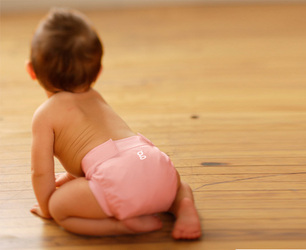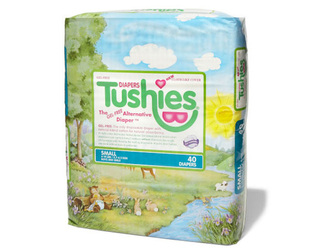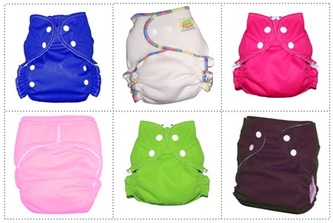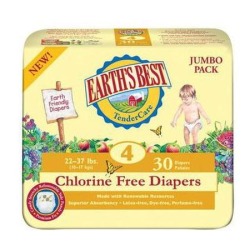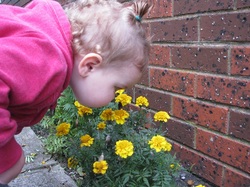Eco-Logic With Kae!
Does Your Baby Poop the Eco-Friendly Way?
Written by Kae - owner of Little Impressions
Going Green has become a huge craze to sweep the nation. From recycling to solar panels someones doing it, but what about babies butt's? "Your baby's go through about 5,000 diapers before being potty trained and 95% of these diaper changes are disposable diapers which means most of them end up in landfills." National Associat: John A. Shiffert, Diaper Services
Eco-Friendly Diapers are toxin-free, making them a healthy choice for your baby. Finding the best cloth, green and biodegradable diapers and the brands that make them can be a challenge. I have listed a few things you should think about while searching.
First thing, think about all the different types of Eco-Friendly Diapers. Each one will fall into one of these categories:
-Flushable Diapers
-Eco-Friendly Cloth Diapers
-Biodegradable Diapers
Biodegradable diapers can be disposed of in two ways: flushing and composting. Yes you can flush these diapers! As long as the diaper is completely free of plastic and is only made of biodegradable materials it is just fine to flush them. When it comes to composting though you do not want to compost the #2 Poo diapers they should always be flushed.
Benefits to the bottom and the family!
Eco-Friendly diapers not only are a benefit to the Earth but these diapers benefit your family aswell. Cloth diapers can save you some green while being green, if you chose to use cloth diapers you never have to purchase more diapers.
Eco-Friendly diapers are healthier for your baby, Eco-Friendly Cloth Diapers are those made of organic cotton and other natural materials. They are not made of harmful toxins or chemicals, that are used in your traditonal diapers.
What should baby wear?
There are many different brand names out there that offer Eco-Friendly diapers that work just as well as tradtional diapers. Here is the list that I have come up with.
-Gdiapers
-Seventh Gereration
-Tushies
-AMP Diapers
-Tender Care Plus
Eco-Friendly diapers are a great solution for parents who want to keep there baby's waste out of the landfills. Cloth diapers are a great solution but remember you have to wash them just about everyday. However, they are not your only option out there. You have the choice of biodegradable diapers. Keep in mind though even biodegradable diapers are not completely Eco-Friendly they dont break down inside of a landfill without air movement.
Wait! Before you make that decision remember...
-Most flushable or biodegradable diapers are made of cornstarch instead of plastic.
-None of these diapers are bleached in chlorine, a process used by disposable-diaper companies that emits toxins into the air and water.
-Contrary to these arguments please remember that no diaper, not even biodegradable ones can break down in an airtight landfill.
-A landfill is NOT a composting facility.
Going Green has become a huge craze to sweep the nation. From recycling to solar panels someones doing it, but what about babies butt's? "Your baby's go through about 5,000 diapers before being potty trained and 95% of these diaper changes are disposable diapers which means most of them end up in landfills." National Associat: John A. Shiffert, Diaper Services
Eco-Friendly Diapers are toxin-free, making them a healthy choice for your baby. Finding the best cloth, green and biodegradable diapers and the brands that make them can be a challenge. I have listed a few things you should think about while searching.
First thing, think about all the different types of Eco-Friendly Diapers. Each one will fall into one of these categories:
-Flushable Diapers
-Eco-Friendly Cloth Diapers
-Biodegradable Diapers
Biodegradable diapers can be disposed of in two ways: flushing and composting. Yes you can flush these diapers! As long as the diaper is completely free of plastic and is only made of biodegradable materials it is just fine to flush them. When it comes to composting though you do not want to compost the #2 Poo diapers they should always be flushed.
Benefits to the bottom and the family!
Eco-Friendly diapers not only are a benefit to the Earth but these diapers benefit your family aswell. Cloth diapers can save you some green while being green, if you chose to use cloth diapers you never have to purchase more diapers.
Eco-Friendly diapers are healthier for your baby, Eco-Friendly Cloth Diapers are those made of organic cotton and other natural materials. They are not made of harmful toxins or chemicals, that are used in your traditonal diapers.
What should baby wear?
There are many different brand names out there that offer Eco-Friendly diapers that work just as well as tradtional diapers. Here is the list that I have come up with.
-Gdiapers
-Seventh Gereration
-Tushies
-AMP Diapers
-Tender Care Plus
Eco-Friendly diapers are a great solution for parents who want to keep there baby's waste out of the landfills. Cloth diapers are a great solution but remember you have to wash them just about everyday. However, they are not your only option out there. You have the choice of biodegradable diapers. Keep in mind though even biodegradable diapers are not completely Eco-Friendly they dont break down inside of a landfill without air movement.
Wait! Before you make that decision remember...
-Most flushable or biodegradable diapers are made of cornstarch instead of plastic.
-None of these diapers are bleached in chlorine, a process used by disposable-diaper companies that emits toxins into the air and water.
-Contrary to these arguments please remember that no diaper, not even biodegradable ones can break down in an airtight landfill.
-A landfill is NOT a composting facility.
Eco-Healthy Measures For Child Care
Written by Kae - owner of Little Impressions
-Eco-Healthy measures for child care:
a. Pesticides and Pest Prevention-
Pesticides and insecticides used to treat pest like roaches and ants as well as weeds, should be non-toxic whether they are inside or outside of the facility.
NOTE⤳ If toxic techniques are required a professional must apply the least toxic treatment available, parents must be notified in advance, and children cannot be exposed for at least 12hrs. after application.
b. Air Quality-
This category is concerned with environmental factors that lead to mold and mildew. These factors include proper ventilation and humidity as well as attention to water leaks.
NOTE⤳ In addition; smoking, scented candles, and air fresheners must be prohibited.
c. Household Chemicals-
The chemicals in common household products used for cleaning or other domestic activities like bleach and paint ca be harmful to children and the environment.
NOTE⤳ Guidelines call for the use of non-toxic and biodegradable products as well as minimal use of bleach. Also facilities should use LOW-VOC (Volatile Organic Compound) paints which have fewer odors and less toxins.
d. Lead-
These measures deal with reducing lead exposure. Avoid use of imported or handmade pottery for food service.
NOTE⤳ Recommended using only cold water for making formula, cooking and drinking. Lead paint was banned in 1978 so facilities built before are at risk of high lead exposure.
NOTE⤳ All visitors, staff, and children should b required to wipe their shoes on a rough mat before entering the facility.
e. Mercury-
Switch to digital thermometers instead of mercury-based thermometers.
f. Furniture and Carpet-
NOTE⤳ Avoid wall to wall carpet and make sure to clean all carpets. Rugs and carpet should be vacuumed daily.
Use biodegradable carpet cleaners at least twice a year to clean area rugs and carpets. Buy solid wood furniture and avoid particle board.
g. Art Supplies-
ACMI provides a complete list of non-toxic supplies which are recommended.
NOTE⤳ Look for ACMI Seals when buying art supplies.
h. Plastics and Toys-
NOTE⤳ Avoid heating plastic items in the microwave. Avoid toys constructed out of soft plastic vinyl. The safest and best is to buy labeled PVC free.
i. Treated Playground Equipment-
When selecting playground equipment avoid items that are made of treated wood.
j. Recycling and Garbage Storage-
Recycle items like glass, paper, plastic, and aluminum. When storing garbage keeping it covered will reduce pests.
-Eco-Healthy measures for child care:
- 10 Categories:
a. Pesticides and Pest Prevention-
Pesticides and insecticides used to treat pest like roaches and ants as well as weeds, should be non-toxic whether they are inside or outside of the facility.
NOTE⤳ If toxic techniques are required a professional must apply the least toxic treatment available, parents must be notified in advance, and children cannot be exposed for at least 12hrs. after application.
b. Air Quality-
This category is concerned with environmental factors that lead to mold and mildew. These factors include proper ventilation and humidity as well as attention to water leaks.
NOTE⤳ In addition; smoking, scented candles, and air fresheners must be prohibited.
c. Household Chemicals-
The chemicals in common household products used for cleaning or other domestic activities like bleach and paint ca be harmful to children and the environment.
NOTE⤳ Guidelines call for the use of non-toxic and biodegradable products as well as minimal use of bleach. Also facilities should use LOW-VOC (Volatile Organic Compound) paints which have fewer odors and less toxins.
d. Lead-
These measures deal with reducing lead exposure. Avoid use of imported or handmade pottery for food service.
NOTE⤳ Recommended using only cold water for making formula, cooking and drinking. Lead paint was banned in 1978 so facilities built before are at risk of high lead exposure.
NOTE⤳ All visitors, staff, and children should b required to wipe their shoes on a rough mat before entering the facility.
e. Mercury-
Switch to digital thermometers instead of mercury-based thermometers.
f. Furniture and Carpet-
NOTE⤳ Avoid wall to wall carpet and make sure to clean all carpets. Rugs and carpet should be vacuumed daily.
Use biodegradable carpet cleaners at least twice a year to clean area rugs and carpets. Buy solid wood furniture and avoid particle board.
g. Art Supplies-
ACMI provides a complete list of non-toxic supplies which are recommended.
NOTE⤳ Look for ACMI Seals when buying art supplies.
h. Plastics and Toys-
NOTE⤳ Avoid heating plastic items in the microwave. Avoid toys constructed out of soft plastic vinyl. The safest and best is to buy labeled PVC free.
i. Treated Playground Equipment-
When selecting playground equipment avoid items that are made of treated wood.
j. Recycling and Garbage Storage-
Recycle items like glass, paper, plastic, and aluminum. When storing garbage keeping it covered will reduce pests.
Little Planters and Potters Gardening Guide
Little Planters and Potters is a gardening guide for parents, grandparents, and educators everywhere. This segment is focused mainly on getting your kids outdoors and practicing gardening ideas as well as eco-friendly measures with them. This segment will feature a monthly gardening tip as well as a weekly blog. I will also be posting some extra goodies so be on the look out.
Since I am still new to the gardening with children idea I have assgined a writer for all the post until I become more confident on the subject. Caroline Roberts is the author of all the posts and the master-mind of Gradening 4 Kids. Check out her site for more info: http://www.gardening4kids.com.au/
Since I am still new to the gardening with children idea I have assgined a writer for all the post until I become more confident on the subject. Caroline Roberts is the author of all the posts and the master-mind of Gradening 4 Kids. Check out her site for more info: http://www.gardening4kids.com.au/
Gardening For the Senses
Written by Caroline Roberts – owner of Gardening 4 Kids (www.gardening4kids.com)
Gardening is beneficial for people of all ages and children are no exception. They have a natural curiosity about nature and spending time out in the garden is full of endless opportunities. We learn through our senses and gardening stimulates all five. It is therefore a fantastic way to develop children’s understanding of the world around them:
Taste – Eating produce fresh from the garden is one of life’s simplest pleasures. Many parents find it difficult to get their children to eat the recommended amount of vegies each day. Children are more likely to eat their greens if they have been actively involved in planting them. They feel a sense of ownership and are often curious to taste the fruits of their labour.
Sight – A garden is full of wonders for children to see. Children enjoy looking at bright and colourful flowers and vegetables grow. They also love watching and learning about butterflies, ladybirds, dragonflies and other insects as they explore the garden. Gardening with your child also gives them the opportunity to develop their own gardening skills by watching what you do.
Sound –Wind blowing in the trees, birds chirping and wind chimes tinkling in the breeze are all beautiful sounds that children enjoy whilst outdoors.
Touch – There are many different textures in a garden that children love to explore. Digging in the dirt, splashing in puddles, feeling the tickle of grass and the roughness of tree bark are all great tactile experiences that children can enjoy and compare.
Smell – Children love smelling new scents and a garden is the perfect place for them to do this. Flowers, herbs and even compost are just a few examples of the variety of scents that are present for children to experience.
Gardening is beneficial for people of all ages and children are no exception. They have a natural curiosity about nature and spending time out in the garden is full of endless opportunities. We learn through our senses and gardening stimulates all five. It is therefore a fantastic way to develop children’s understanding of the world around them:
Taste – Eating produce fresh from the garden is one of life’s simplest pleasures. Many parents find it difficult to get their children to eat the recommended amount of vegies each day. Children are more likely to eat their greens if they have been actively involved in planting them. They feel a sense of ownership and are often curious to taste the fruits of their labour.
Sight – A garden is full of wonders for children to see. Children enjoy looking at bright and colourful flowers and vegetables grow. They also love watching and learning about butterflies, ladybirds, dragonflies and other insects as they explore the garden. Gardening with your child also gives them the opportunity to develop their own gardening skills by watching what you do.
Sound –Wind blowing in the trees, birds chirping and wind chimes tinkling in the breeze are all beautiful sounds that children enjoy whilst outdoors.
Touch – There are many different textures in a garden that children love to explore. Digging in the dirt, splashing in puddles, feeling the tickle of grass and the roughness of tree bark are all great tactile experiences that children can enjoy and compare.
Smell – Children love smelling new scents and a garden is the perfect place for them to do this. Flowers, herbs and even compost are just a few examples of the variety of scents that are present for children to experience.
